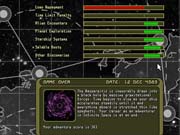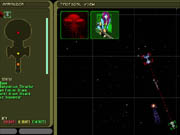Cheapass Games is known by board-game aficionados as a publisher of simple, fast, and surprisingly fun games with fairly low production values and very low prices. Strange Adventures in Infinite Space translates almost everything that is fun about this type of gaming to the computer without feeling like a computer port of something you'd have found 20 years ago in Dragon magazine. Paradoxically, the concept and mechanics of Strange Adventures are very similar to those of the old magazine games. The graphics are extremely dated, and the sound is minimal, but the basic idea and implementation are outstanding.

The game's concept is simple: You're presented with a playing field of roughly 15 stars. Your task is to explore as many of them as possible in 10 years, bring back as many valuable artifacts and exotic life-forms to your home planet as you can, and defeat as many aliens as possible along the way. Traveling from star to star is measured in days, and passing through nebulae significantly increases your travel time, so you have to plan your travels somewhat. Once you reach an unexplored system, you are presented with an encounter. It can be an alien race, an artifact, a new life-form, or perhaps a friendly starship that will join your flotilla. As you proceed from system to system, you collect your findings and fight (or trade with) aliens in preparation for bringing your booty back to your home system.
Your starship has upgradeable components that you can improve as you find new items in your travels. Many of the things you find will be useful to you on board your craft. Early on you have basic weapons, shields, and drives, but after a few chance encounters with some new ships, as well as the acquisition of a new weapon or two, your little armada can become quite formidable. Because this is completely random, you'll find some games where you're completely on your own, and others where you're a miniature fleet admiral. Part of the fun of the game is taking advantage of opportunities to fight when they're presented to you by chance.
Starship combat involves a pauseable real-time system that takes weapon ranges, ship speed, and component types into account. There are a number of alien races you can encounter, and there is even a combat simulator in which you can test out various weapons and strategies against different enemies. One of the most amusing episodes we experienced was the sight of a ship being harassed by a single tiny fighter. Because the ship was only armed with slow missiles, it could never get them to hit the fighter, which kept outmaneuvering the attacks. However, the fighter could not inflict enough damage to punch through the larger ship's shields. The result was a standoff that was as whimsical as the game itself.

The randomness of the game makes it difficult to plan a strategy, since so much depends on what your encounters present to you. If you're lucky to find an improved interstellar drive early on, you'll likely be able to explore most of the planets and get a high score. However, it's quite possible that at some point on your return journey you'll run into a previously undiscovered black hole and have to choose between turning back and going a different way or proceeding and possibly being blown up. Since the game penalizes you heavily for taking longer than 10 years to carry out your mission, you'll seriously hurt your score if you retreat, so you have little choice but to proceed. These types of random encounters make Strange Adventures seem a bit like an adventure game, where you don't quite know what's going to happen and are in a sense just along for the ride.
The game's short length is what makes it so engaging. In a longer game, the random nature of the encounters and lack of player input would become frustrating, but since you can finish a game in five to 15 minutes, you can always just start another one immediately afterward. Strange Adventures is an addictive little game much like Bejeweled or Tetris, but instead of being a puzzle, it's a little adventure that you can lose yourself in for a few minutes at a time. For $15, it's a great buy that will end up being one of those games you keep running in the background and fire up for a while when you need a break. Designers Rich Carlson and Iikka Keranen have managed to capture the feeling of "what will happen next?" that marked gameplay in very early computer games, with a style that is attractive today.